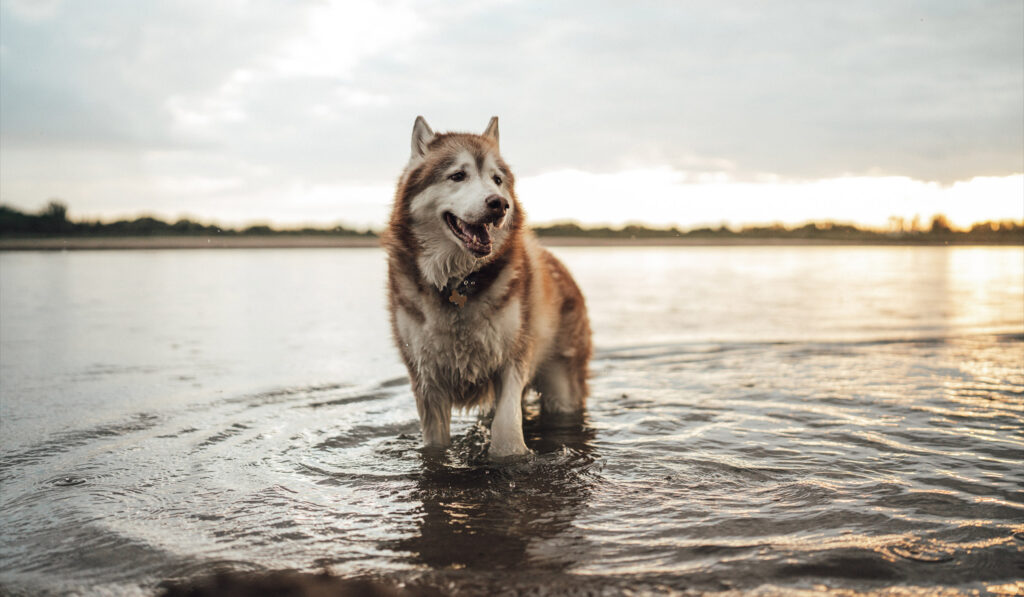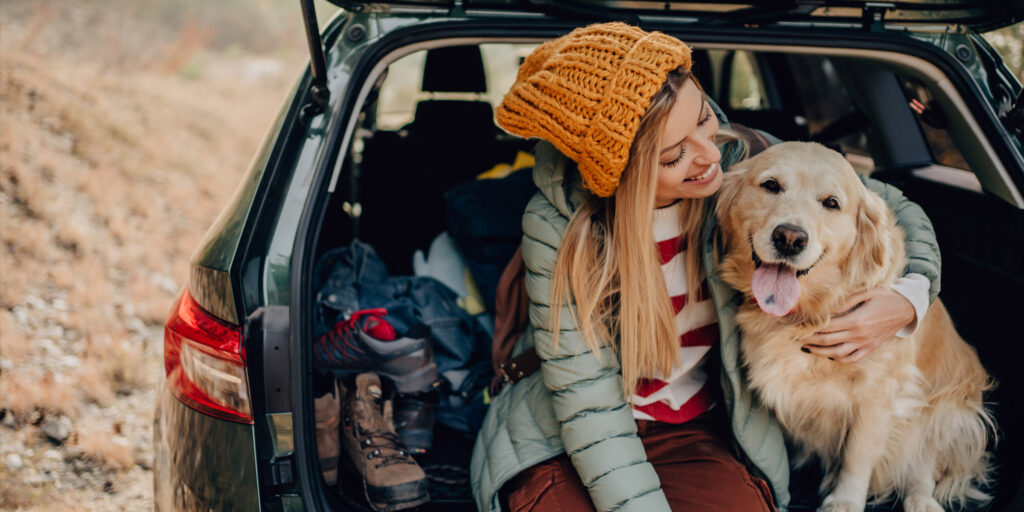Camping with Dogs: How to Keep Your Dog a Happy Camper
Camping with dogs: How to keep your dog a happy camper
Travelling with a dog can be tricky, especially when you’re heading somewhere they’ve never been before. New sights, sounds, smells, and experiences can be equal parts overwhelming and exhilarating for your pet.
To help you have the best (and safest) time camping with your dog this summer, we’ve rounded up a few of our favourite outdoor travel tips.
Dog friendly camping: Making the most of the great outdoors
After a long winter, it feels great to get outside and connect with nature. Even better is knowing you get to enjoy it with your dog.
Whether you’re new to camping with dogs or an avid and experienced camper, there is much to consider. Here are a few of our top tips:
- Make sure your final destination is dog-friendly. Don’t be shy—call ahead to find out! If yes, make sure you also ask about their leash requirements; some campgrounds may have designated off-leash areas while others may strictly enforce that your dog is leashed at all times.
- Search up nearby animal hospitals. Your campground of choice may have this information on hand, but if not it’s a good idea to run a quick Google search to find out how far you’ll need to travel in case of an emergency. Keep your family veterinarian on speed dial just in case (along with a Waggle Mail first aid kit).
- Do a tent trial run. Whether you’re camping with dogs in a tent or an RV, it’s important to familiarize your dog with their temporary shelter. Start by pitching a tent in your backyard, or taking an overnight trip to a nearby dog-friendly park. The more they’re exposed to the overall camping with dogs experience, the more comfortable they’ll likely be.
- Make the space feel (and smell) like home. Furnishing your tent or RV with a beloved bed, blanket and toys may help put them at ease. If your dog needs an extra boost of zen, give calming pheromones a try; brands like Adaptil® are great for on the go.
- Learn about local wildlife, plants, and insects. Understanding what risks are present at your final destination will help protect your pet. Traveling with vet-approved mosquito repellents, sunscreen for dogs, and proper flea medications will help keep the bugs at bay.
- Play hard, sleep hard. camping with dogs trips never feel long enough, do they? While it’s great to fill your days with fun outings and adventures, make sure you schedule plenty of water breaks and rest. Too much go-go-go can lead to canine heat exhaustion or physical overexertion.
- Practice campfire safety. Gathering around the campfire is arguably one of the best parts of camping, but when you’re traveling with a dog you’ll want to take extra precautions to ensure they enjoy the experience as much as you do. Keeping your dog well away from the fire prevents smoke ingestion and burnt paws from walking across hot embers.
- Don’t leave your dog unattended. Unless absolutely necessary (and for only a short period of time), your dog should never be left unattended at your campsite. Especially for dogs with separation anxiety, they may already be on edge in an unfamiliar environment and accidentally get themselves into trouble. Even when you’re present, your dog should always be sheltered from wildlife and other environmental hazards.
Now that your campsite is covered, let’s talk about the focal point of many camping with dogs trips: the water.
Water safety for dogs: What pet parents need to know
Whether you’re going camping with dogs, glamping, or posting up in a cozy log cabin, it’s generally the case that a body of water is nearby.

You might assume that all dogs do well in the water, but before you float, boat, or head out for a swim or a paddle, it’s important to have a handle on some water safety basics:
EXPERT TIP: As the water gets deeper, support your dog’s midsection until they appear to relax and propel themselves forward by paddling with their front legs. Lifting your dog’s hind legs will help show them how to float, too.
- Not all dogs are strong swimmers. Even if they are, too much fun in the sun can spell out trouble (heat exhaustion or hypothermia, to name a few). If you aren’t sure how well your dog will do in the water, don’t dive into the deep end—choose a quiet, shallow spot and ease your way in, gauging your dog’s comfort level along the way.
- Pack a life jacket. Especially if you’re bringing your dog on a boat, a dog-friendly life jacket is a must. Between fast currents, fatigue, and muscle cramps, it’s better to be safe than to have to contend with unexpected unknowns. Even if you’ve been working on your beach body, your dog will feel heavier when wet, and large breed dogs can be difficult to pull from the water.
EXPERT TIP: Choose a life jacket with a handle on the back to help you get them back onto the boat. An inflatable e-collar can give added support for chest-heavy breeds like pitbulls and bulldogs.
- Stay away from sticks. Even though they’re a fetch favorite of many dogs, it’s safer to choose a bright-colored ball or a floating toy instead.
- Remove any collars before entering the water. This is especially important if your dog uses a slip or chain collar because they can accidentally snag on branches or other below-the-surface hazards. The same goes for flea and pheromone collars; water can remove their active ingredients.
- Monitor for signs of heat stroke. Heavy breathing, excessive panting, and dry gums may indicate heat exhaustion and should be treated as soon as possible.
- Keep an eye out for the swimmer’s ear. Ear infections can put a painful damper on your camping trip. As soon as possible after a swim, rinse your dog with clean, freshwater. (There are plenty of vet-approved ear cleansers, too.) If your dog has sensitive skin, a quick shampoo will give an added layer of protection from minerals, bacteria, and other waterborne pollutants.
- Don’t forget the sunscreen! Did you know the sun’s rays intensify around water? Protect your pooch with vet-approved sunscreen (and provide shade where possible).
Speaking of packing…
Dog Camping Gear: The essential checklist for camping with dogs
To help ease the pains of packing, we’ve put together a checklist of must-haves when traveling with a dog or going out for camping with dogs:
- A copy of your dog’s up-to-date vaccinations (printed or digital… or both!)
- A recent photo for your dog
- Medications
- Crate, safety harness, or other restraining devices
- Leash with stake or tether
- Fresh food and water
- Dog treats
- Bowls (stainless steel and collapsible silicone dishes are both great options)
- Waste disposal bags
- Cleaning supplies
- Grooming and other gear like a brush, rain jacket, and daypack
- Dog-friendly mosquito repellent and sunscreen
- Toys (pair some old favourites with a few new outdoor-safe ones to keep them excited and entertained in the car and at the campsite)
- Dog camping bed
- Blanket and/or towel (nights can get chilly when you’re in a tent)
- A Waggle Mail first aid kit

Once you’re on the move, plan a roadside water and bathroom break for your dog every few hours. And although this one goes without saying, we’ll say it anyway: never leave your pets unattended inside a car. In as little as two minutes, your car temperature can spike by more than 15 degrees.
If you found these pet travel tips and camping with dogs tips helpful, share them with a friend. The more, the merrier!
Want more Waggle? Subscribe to Waggle (e)Mail. We love sharing fun and effective ways to promote canine health and wellness to our pack members.

